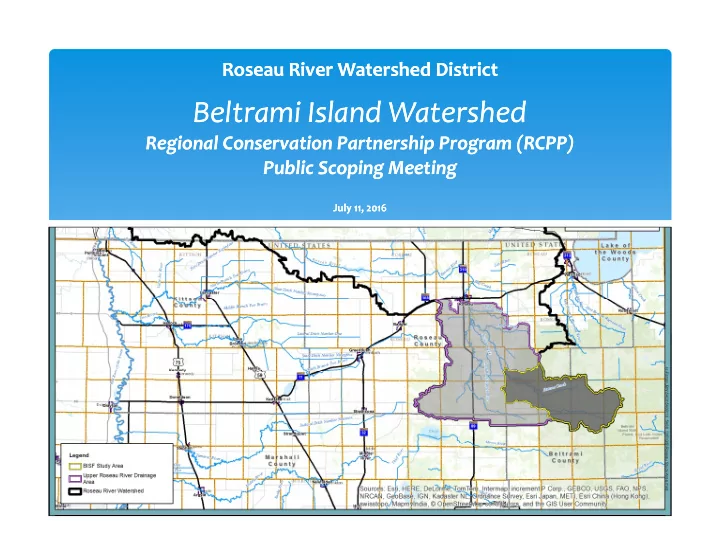

Roseau River Watershed District Roseau River Watershed District Beltrami Island Watershed Beltrami Island Watershed Regional Conservation Partnership Program (RCPP) Regional Conservation Partnership Program (RCPP) Public Scoping Meeting Public Scoping Meeting July 11, 2016 July 11, 2016 Will be modified – map from GIS – 6/16 EOD
Beltrami Island Sub-Watershed Beltrami Island Sub-Watershed Public Scoping Meeting Public Scoping Meeting OBJECTIVES OBJECTIVES 1. Overview - PL566 Planning process 2. Solicit Comments on the Resource Concerns 3. Inform Public of Future Steps
Beltrami Island Sub-Watershed Beltrami Island Sub-Watershed Public Scoping Meeting Public Scoping Meeting AGENDA AGENDA 1. Introduce Study Area 2. Public Law 566 Planning Process Overview 3. Watershed Setting and Resource Concerns 4. Overview of Next Steps 5. Questions/Public Comment Period
Study Area Roseau River Watershed - 2057 sq. mi. Upper Roseau River Watershed - 477 sq. mi. BISF Sub-Watershed - 145 sq. mi.
Study Area
Regional Conservation Partnership Program (RCPP) • 2014 Farm Bill • Red River Retention Authority awarded $12M • RRRA approved 20 Watershed Planning Efforts • 14 Minnesota, 6 North Dakota • RRWD • BISF and Whitney Lake
RCPP Planning Process INITIATE PLANNING ∗ Discuss purpose and need for project with sponsors/Initiate study. Step 1 - IDENTIFY PROBLEMS, OPPORTUNITIES & CONCERNS ∗ Identify the need for the proposed action (quantify, extent, magnitude, timing, frequency etc.) Step 2 - DETERMINE OBJECTIVES ∗ Write purpose and need statement and Write scope of plan-EA/EIS Step 3 - INVENTORY RESOURCES ∗ Conduct detailed resource inventories and watershed assessment ∗ Economics, social effects, Archeological and historic resources ∗ Engineering/Geology/Support maps ∗ Document problems Step 4 - ANALYZE RESOURCE DATA ∗ Geology, Hydrology & Hydraulics, Cultural, Economics and Social Step 5 - FORMULATE ALTERNATIVES ∗ Develop reasonable alternatives, mitigation strategies and costs (Preliminary plans) Step 6 - EVALUATE ALTERNATIVES ∗ Env. Resources, Geotechnical, Hydrology & Hydraulics, Economics, Significance of effects,… Step 7 - MAKE DECISIONS (EA/EIS, Public Involvement,…)
RCPP Planning Process - NEPA RCPP planning process will follow NEPA guidelines ∗ 40 CFR 1506.6 – Public Involvement ∗ Primary Goal ∗ Ensure all interested and affected parties are aware of the proposed action (a) “make diligent efforts to involve the public in preparing and implementing their NEPA procedures.”
Why RCPP? COST SHARE BREAKDOWN 30% LOCAL 70% NRCS
Watershed Setting and Known Resource Concerns
Problems – Flooding/Flood Damages
Natural Resource and Water Quality Concerns ∗ Channel instability ∗ Lack of riparian buffers ∗ Degradation and loss of existing grassland and wetland habitats (ex. CRP conversion) ∗ Soil erosion (wind and water) from upland sources ∗ Degraded soil health
Natural Resource Goals Roseau River Watershed Overall Plan (2004) ∗ Protect, restore, and enhance streams in the Roseau River watershed to support sustainable aquatic communities, ∗ Manage wetland and upland habitats to support sustainable wildlife communities, ∗ Protect and restore unique natural resource communities, ∗ Increase and promote outdoor recreational activities related to fish, wildlife and other natural resources in the watershed, and ∗ Improve water quality in the Roseau River watershed.
Overview of Next Steps
Watershed Planning Timeline 1-3 Months 6-12 Months 3-6 Months 12+ Months ∗ Plan of Work ∗ Finalize Ex. H&H ∗ Purpose & Need ∗ Alternative ∗ Develop Team ∗ Without Project ∗ Scope EA Screening ∗ Geotech ∗ Feasibility Report Conditions ∗ Field Survey ∗ Economics: ∗ Impacted Lands ∗ Define Concerns ∗ Ex. H&H Modeling ∗ Preliminary ∗ Alternatives for ∗ Public Meeting ∗ Field Inventory Alternative Detailed Study ∗ Field Survey ∗ Begin Economics Screening ∗ H&H ∗ Begin H&H ∗ Preliminary Alternatives Cultural Review ∗ Detailed Survey, Geotech, Design
Questions/Comments/ Form Completion
Public Input
Public Input
Questions
POSTERS
Study Area/RCPP Overview
RCPP Planning Process INITIATE PLANNING ∗ Discuss purpose and need for project with sponsors/Initiate study. Step 1 - IDENTIFY PROBLEMS, OPPORTUNITIES & CONCERNS ∗ Identify the need for the proposed action (quantify, extent, magnitude, timing, frequency etc.) Step 2 - DETERMINE OBJECTIVES ∗ Write purpose and need statement and Write scope of plan-EA/EIS Step 3 - INVENTORY RESOURCES ∗ Conduct detailed resource inventories and watershed assessment ∗ Economics, social effects, Archeological and historic resources ∗ Engineering/Geology/Support maps ∗ Document problems Step 4 - ANALYZE RESOURCE DATA ∗ Geology, Hydrology & Hydraulics, Cultural, Economics and Social Step 5 - FORMULATE ALTERNATIVES ∗ Develop reasonable alternatives, mitigation strategies and costs (Preliminary plans) Step 6 - EVALUATE ALTERNATIVES ∗ Env. Resources, Geotechnical, Hydrology & Hydraulics, Economics, Significance of effects,… Step 7 - MAKE DECISIONS (EA/EIS, Public Involvement,…)
Watershed Planning Timeline 1-3 Months 6-12 Months 3-6 Months 12+ Months ∗ Plan of Work ∗ Finalize Ex. H&H ∗ Purpose & Need ∗ Alternative ∗ Develop Team ∗ Without Project ∗ Scope EA Screening ∗ Geotech ∗ Feasibility Report Conditions ∗ Field Survey ∗ Economics: ∗ Impacted ∗ Define Concerns ∗ Ex. H&H Modeling ∗ Damages Lands ∗ Public Meeting ∗ Field Inventory ∗ Preliminary ∗ Alternatives for ∗ Field Survey ∗ Begin Economics Alternative Detailed Study ∗ Begin H&H Screening ∗ H&H ∗ Preliminary Alternatives Cultural Review ∗ Detailed Survey, Geotech, Design
Public Comment
Public Input
Public Input
What Do You Value MOST? C stickers HERE � FLOODING FLOOD DAMAGES Photo by: Jeff Kienitz C stickers HERE � WATER QUALITY EROSION SEDIMENTATION C stickers HERE � WILDLIFE HABITAT
Flooding and Flood Damages
Water Quality/Erosion and Sedimentation
Water Quality/Erosion/Sedimentation
Water Quality/Erosion/Sedimentation
Water Quality/Erosion/Sedimentation
Water Quality/Erosion/Sedimentation
Wildlife and Habitat
Natural Resource Goals Roseau River Watershed Overall Plan (2004) ∗ Protect, restore, and enhance streams in the Roseau River watershed to support sustainable aquatic communities, ∗ Manage wetland and upland habitats to support sustainable wildlife communities, ∗ Protect and restore unique natural resource communities, ∗ Increase and promote outdoor recreational activities related to fish, wildlife and other natural resources in the watershed, and ∗ Improve water quality in the Roseau River watershed.
Recommend
More recommend